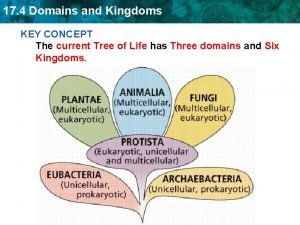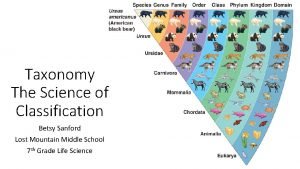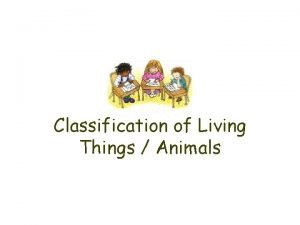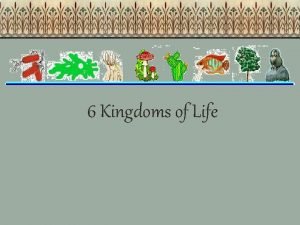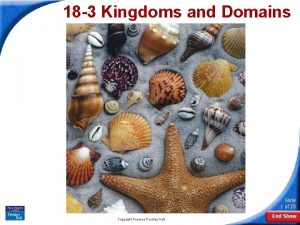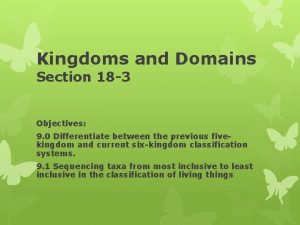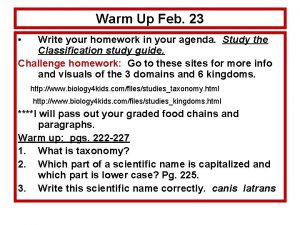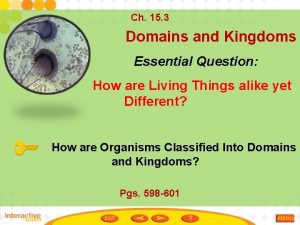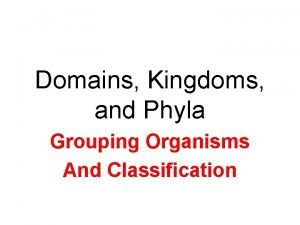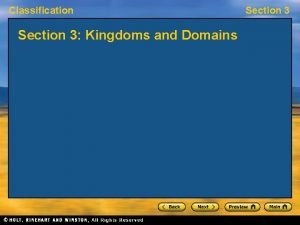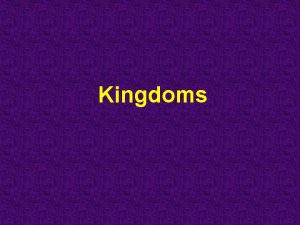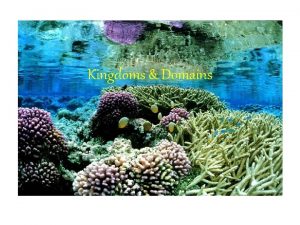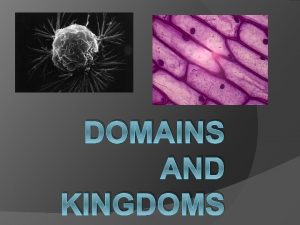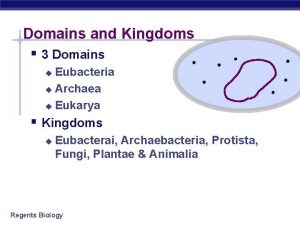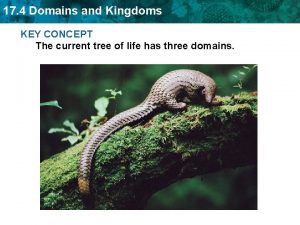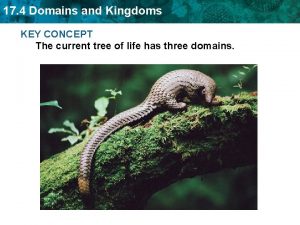17 4 Domains and Kingdoms KEY CONCEPT The













- Slides: 13

17. 4 Domains and Kingdoms KEY CONCEPT The current tree of life has three domains.

17. 4 Domains and Kingdoms Classification is always a work in progress. • The tree of life shows our most current understanding. • New discoveries can lead to changes in classification. – Until 1866: only two kingdoms, Plantae Animalia and Plantae Animalia

17. 4 Domains and Kingdoms Classification is always a work in progress. • The tree of life shows our most current understanding. • New discoveries can lead to changes in classification. – Until 1866: only two kingdoms, Plantae Animalia and Plantae Animalia – 1866: all single-celled Protista organisms moved to kingdom Protista

17. 4 Domains and Kingdoms Classification is always a work in progress. • The tree of life shows our most current understanding. • New discoveries can lead to changes in classification. – Until 1866: only two kingdoms, Plantae Animalia and Plantae Animalia – 1866: all single-celled Protista organisms moved to kingdom Protista – 1938: prokaryotes moved to kingdom Monera

17. 4 Domains and Kingdoms Classification is always a work in progress. • The tree of life shows our most current understanding. • New discoveries can lead to changes in classification. – Until 1866: only two kingdoms, Plantae Animalia and Plantae Animalia – 1866: all single-celled Protista organisms moved to kingdom Protista – 1938: prokaryotes moved to kingdom Monera – 1959: fungi moved to own kingdom Monera Fungi

17. 4 Domains and Kingdoms Classification is always a work in progress. • The tree of life shows our most current understanding. • New discoveries can lead to changes in classification. – Until 1866: only two kingdoms, Plantae Animalia and Plantae Animalia – 1866: all single-celled Protista organisms moved to kingdom Protista – 1938: prokaryotes moved to kingdom Monera – 1959: fungi moved to own kingdom Archea Fungi Bacteria – 1977: kingdom Monera split into kingdoms Bacteria and Archaea

17. 4 Domains and Kingdoms The three domains in the tree of life are Bacteria, Archaea, and Eukarya. • Domains are above the kingdom level. – domain model more clearly shows prokaryotic diversity

17. 4 Domains and Kingdoms • Domain Bacteria includes prokaryotes in the kingdom Bacteria. – one of largest groups on Earth – classified by shape, need for oxygen, and diseases caused

17. 4 Domains and Kingdoms • Domain Archaea includes prokaryotes in the kingdom Archaea. – cell walls chemically different from bacteria – differences discovered by studying RNA – known for living in extreme environments

17. 4 Domains and Kingdoms • Domain Eukarya includes all eukaryotes. – kingdom Protista

17. 4 Domains and Kingdoms • Domain Eukarya includes all eukaryotes. – kingdom Protista – kingdom Plantae

17. 4 Domains and Kingdoms • Domain Eukarya includes all eukaryotes. – kingdom Protista – kingdom Plantae – kingdom Fungi

17. 4 Domains and Kingdoms • Domain Eukarya includes all eukaryotes. – – kingdom Protista kingdom Plantae kingdom Fungi kingdom Animalia – Made up of Eukaryotic cells – May be single celled or multicellular
 Concept mapping domains and kingdoms
Concept mapping domains and kingdoms Chapter 17 section 3 domains and kingdoms answer key
Chapter 17 section 3 domains and kingdoms answer key Genus family class order
Genus family class order What are the 3 domains and 6 kingdoms of classification
What are the 3 domains and 6 kingdoms of classification Kingdoms of life
Kingdoms of life Invertebrates animals
Invertebrates animals Organizing life's diversity section 3 domains and kingdoms
Organizing life's diversity section 3 domains and kingdoms What are the six kingdoms of life
What are the six kingdoms of life Section 18-3 kingdoms and domains
Section 18-3 kingdoms and domains Section 18-3 kingdoms and domains
Section 18-3 kingdoms and domains Flow chart of domains and kingdoms
Flow chart of domains and kingdoms How are organisms classified into domains and kingdoms
How are organisms classified into domains and kingdoms Archaea kingdoms
Archaea kingdoms What are the three domains and six kingdoms?
What are the three domains and six kingdoms?
